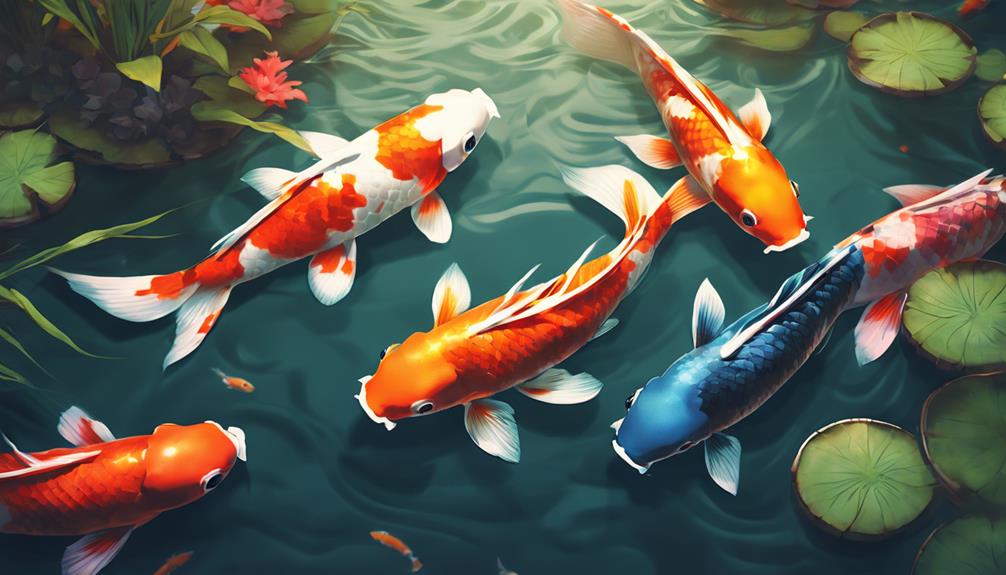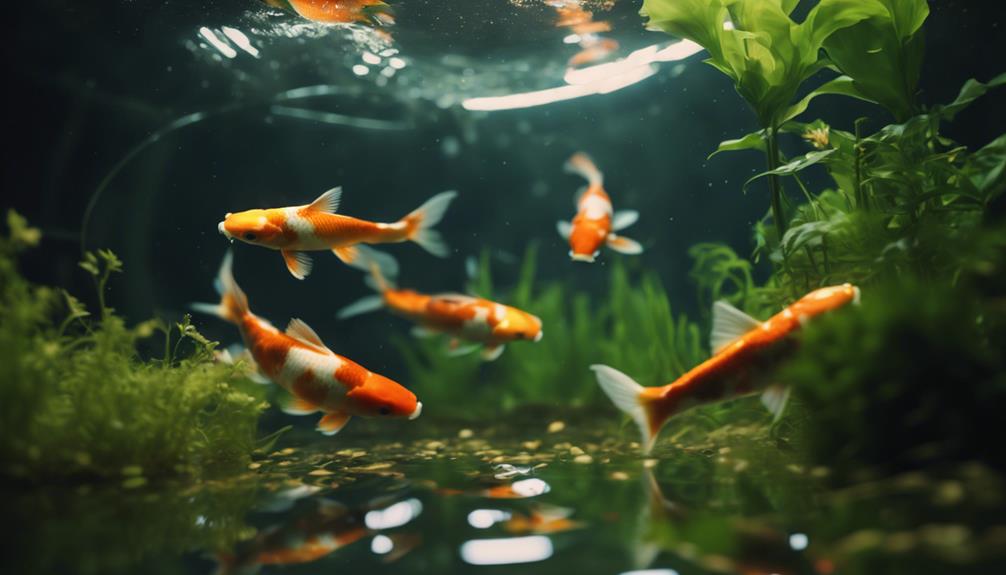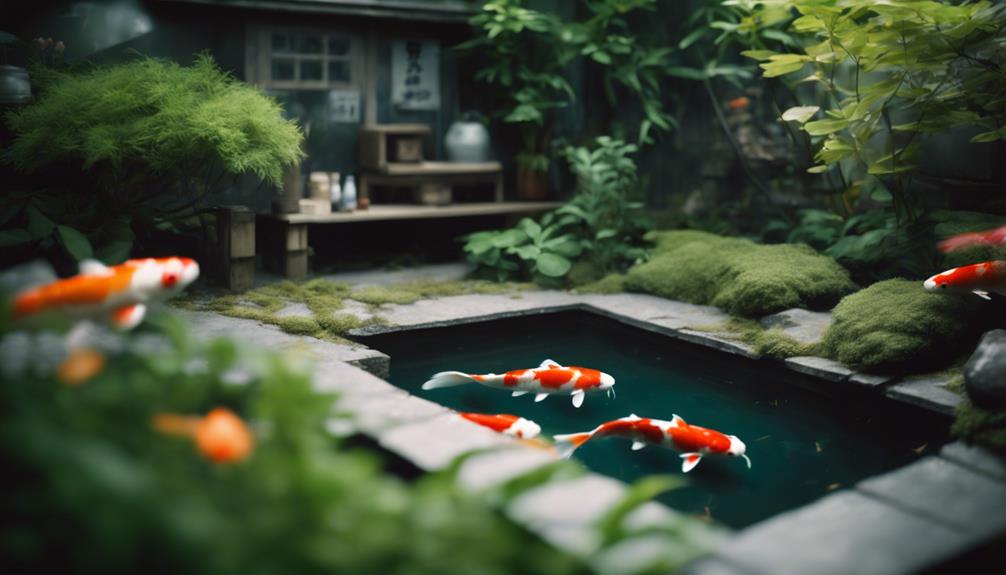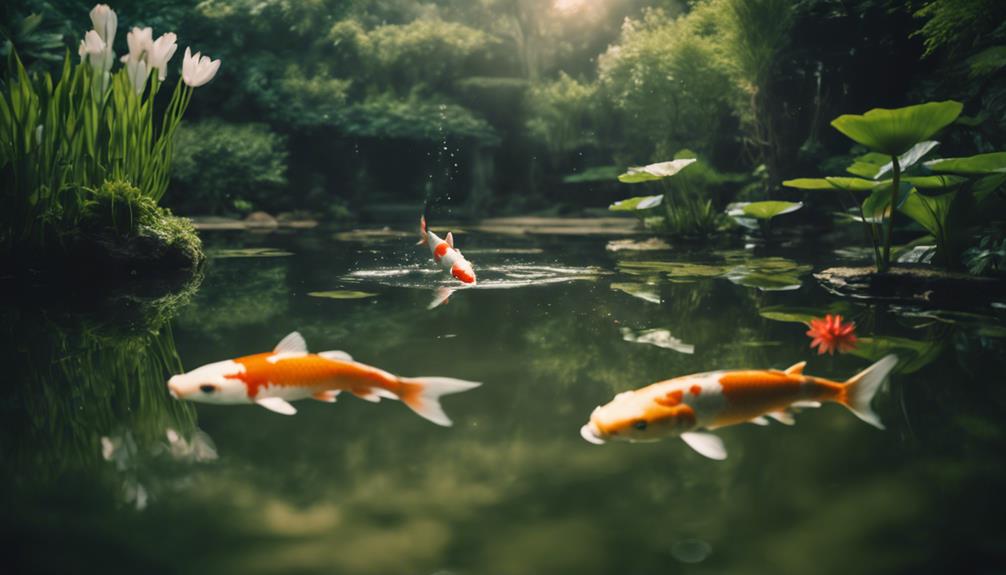You're about to reveal the secrets to successfully breeding healthy koi fish. First, guarantee your pond water quality is pristine and stable, with a temperature between 65°F and 75°F. Add a spawning rope and plants or spawning mats to create an ideal environment. Select breeding stock that's at least 3 years old, with desirable traits like healthy scales and fin shape. Monitor water quality closely, and remove adult koi from the breeding tank to prevent them from eating eggs. Provide nutrient-rich food to support rapid growth, and maintain a pristine breeding environment to prevent disease and stress. Now, get ready to take your koi breeding skills to the next level.
Table of Contents
Key Takeaways
- Ensure a pristine pond environment with stable water quality, ideal temperature, and proper filtration to promote healthy spawning and development.
- Select breeding stock with desirable traits, such as healthy scales, fin shape, and color, and ensure they are at least 3 years old and sexually mature.
- Provide a safe and natural surface for koi to spawn on, such as a spawning rope or plants, and monitor water temperature regularly to create an ideal environment.
- Guarantee a reliable filter system and spotless cleanliness in the koi tank to support the health of baby koi, and remove unfertilized eggs to prevent fungus growth.
- Feed baby koi nutrient-rich food, such as live foods or commercial baby koi meal kits, and monitor their growth and development to adjust feeding amounts accordingly.
Preparing for Breeding Season
As you approach the koi fish breeding season, take stock of your pond's water quality, verifying it's pristine and stable to promote healthy spawning and development. This is a critical step in preparing for breeding season, as it directly impacts the success of your koi breeding program. You want to create the Right Conditions for your fish to thrive.
Choose koi that are healthy and well-suited for breeding. Select a mix of male and female fish, as they'll begin to show signs of courtship behavior when the breeding season arrives. Make sure your pond is large enough to accommodate the fish, and that it's free from stressors that could disrupt the breeding process.
When the breeding season arrives, your koi will begin to lay their eggs. To guarantee a successful spawn, keep the water clean and well-oxygenated. Monitor the water temperature and pH levels, making adjustments as needed. By preparing for breeding season and creating the ideal environment, you'll be well on your way to raising successful koi.
Creating Ideal Mating Conditions
When creating ideal mating conditions for your koi, you'll want to focus on two critical factors: perfect water temperature and a safe spawning environment.
By getting these elements just right, you'll be setting your fish up for a successful and stress-free breeding experience.
In the following discussion, we'll explore the specifics of what that means and how you can achieve it.
Optimal Water Temperature
Maintain a water temperature between 65°F and 75°F (18°C and 24°C) to create an ideal environment for koi fish breeding, as this range fosters healthy development and encourages spawning.
This perfect water temperature allows your koi to thrive and increases the chances of successful breeding.
In late spring or early summer, when the water temperature reaches this range, your koi will spawn naturally in your water garden.
To breed koi, prioritize koi pond filtration, ensuring the water is clean and healthy prior to spawning. You can even add a spawning rope to your pond to provide a safe and natural surface for your koi to spawn on.
By maintaining the perfect water temperature, you'll create a perfect setting for your koi to mate and reproduce.
Remember, a healthy environment is vital for successful breeding, so make sure to monitor your water temperature regularly and adjust it if necessary.
With the right conditions, your koi will spawn and thrive, allowing you to enjoy the beauty of these stunning fish in your own backyard.
Safe Spawning Environment
By creating a safe and conducive spawning environment, you can substantially increase the chances of successful koi breeding, and underwater plants play a crucial role in providing a secure haven for your fish to spawn and lay eggs.
To stimulate spawning, provide shallow water, either in a pond or a temporary pool, and maintain a temperature range of 18-25°C.
Use a clean and parasite-free spawning pool: Avoid using water from the main pond to prevent parasite transfer.
Provide safe places for koi to spawn: Use spawning ropes or fine mesh to mimic natural spawning conditions.
Leave the parents undisturbed: Remove them once the female has stopped laying eggs to prevent them from eating the eggs.
Selecting Healthy Breeding Stock

When selecting healthy breeding stock, you'll want to focus on koi that exhibit specific characteristics.
You're looking for fish that have reached a certain age, as this is a key indicator of their ability to produce healthy offspring.
Koi Breeding Age Matters
Selecting breeding stock at the right age is crucial, as koi that are too young or too old can substantially impact the success of your breeding program.
You want to guarantee that your koi parents are sexually mature and capable of producing healthy offspring. As a rule of thumb, koi should be at least 3 years old before breeding.
Koi under 3 years old may not be fully mature, which can lead to breeding failures or unhealthy offspring.
Breeding stock with desirable traits like healthy scales, fin shape, and color increases the chances of passing these traits to their offspring.
Selecting breeding stock within the prime age range guarantees that they're capable of producing viable eggs or sperm, increasing the likelihood of successful breeding.
Healthy Scales Indicate Quality
You'll want to carefully examine the scales of your potential breeding stock, as healthy scales are a key indicator of quality and a reflection of the fish's overall health and genetic makeup.
Healthy scales on both male and female koi are essential for producing high-quality offspring with desirable traits.
Look for scales that are shiny and metallic, free of damage such as cracks, holes, or excessive wear.
Koi with healthy scales tend to have a stronger immune system, making them more resilient to disease and environmental stressors.
This, in turn, increases the chances of producing healthy koi fry.
When selecting breeding stock, avoid koi with white growths or other signs of poor health.
Providing your koi with a balanced diet rich in protein supplements can also help promote healthy scales.
Desirable Fin Shape Counts
Two key fin shape characteristics to look for in healthy breeding stock are a symmetrical caudal fin and a balanced dorsal fin, as these features are crucial indicators of a koi's overall health and genetic quality.
When selecting breeding stock, you want to choose fish with desirable fin shape, as this is an important characteristic in determining the quality and beauty of the fish. Well-formed fins indicate good health and genetics, which will be passed on to their offspring.
- Good health: Koi with symmetrical and balanced fins are more likely to be healthy and robust, making them better breeding stock.
- Strong genetics: Desirable fin shape is an indicator of good genetics, which will be passed on to their offspring, ensuring healthy and vibrant young.
- Quality offspring: By breeding koi with desirable fin shape, you'll be more likely to produce healthy offspring with vibrant colors and patterns, strong immune systems, and robust bodies.
Caring for Koi Eggs and Fry
Caring for koi eggs and fry requires meticulous attention to detail, as the fragile young fish are highly susceptible to disease and death in a dirty or poorly maintained environment.
You'll need to guarantee your koi tank has a reliable filter system and is spotlessly clean to support the health of your baby koi.
Monitor water quality closely, making adjustments as necessary to maintain ideal conditions: a temperature range of 65-75°F and pH 6.5-8.5.
Remove any unfertilized eggs, which are usually whitish and fuzzy, to prevent fungus growth and contamination of the tank.
Providing a fry mat in your pond can increase the chances of successful breeding, and don't forget to remove adult koi from the breeding tank to prevent them from eating the eggs.
By following these guidelines, you'll create a clean and healthy environment for your koi eggs and fry to thrive.
Feeding and Nourishing Young Koi

After the initial 24-hour period where they rely on their yolk sac, it's essential that you start providing your baby koi with nutrient-rich food to support their rapid growth and development. As a responsible breeder, you want your tiny fry to be well fed and healthy.
For the first few days, you can use live foods or commercial baby koi meal kits. Some breeders also use a homemade chicken egg preparation.
After 10 days, you can start feeding your baby koi powdered koi pellets, four times a day. Continue to feed powdered food until they're around 4 weeks old. At this stage, you can gradually increase the food size. By the time they're 1 month old, you can feed them crumb-sized pellet pieces.
Feed frequently: Baby koi have high energy needs, so feed them often.
Use the right food: Powdered koi pellets or fine powder are ideal for young koi.
Monitor their growth: Adjust feeding amounts based on your koi's growth and development.
Maintaining a Healthy Breeding Environment
Maintaining a pristine breeding environment is crucial to the health and well-being of your koi, as a contaminated or poorly maintained space can quickly lead to disease and stress.
With years of experience, you know that a specialized koi pond is essential for breeding healthy koi. You're committed to providing the best environment for your fish, and that starts with a clean pond.
Use a skimmer regularly to remove debris and excess food from the surface area of the pond water. This will help maintain a stable air temperature and prevent the buildup of toxic gases.
Provide a place to lay eggs by adding plants or spawning mats to the pond. When the females are ready to spawn, usually around the full moon, remove the males to prevent them from eating the eggs.
Feed your koi powdered koi food to guarantee they're getting the nutrients they need to thrive.
Managing Risks and Challenges

You'll inevitably face challenges and risks when breeding koi, from unexpected water temperature fluctuations to aggressive behavior among your fish. Being prepared and taking steps to mitigate these issues is vital.
During the breeding season, which typically occurs in the spring and summer, males and females can become aggressive towards each other.
Monitor water parameters: Regularly check water temperature, pH, and ammonia levels to prevent sudden changes that can harm your koi.
Use a skimmer net and sticky pad: Remove any koi with torn fins or signs of injury to prevent infection and reduce stress.
Be patient and let nature take its course: Trying to breed koi can be a full-time job, but allowing the breeding process to unfold naturally is paramount to increase your chances of success.
Frequently Asked Questions
How Do You Breed a Koi Successfully?
You'll successfully breed koi by selecting healthy, mature fish, preparing a clean breeding environment with ideal water conditioning, understanding spawning triggers, and providing a nutrient-rich diet, while embracing genetic diversity and mastering breeding techniques.
How to Encourage Koi Spawning?
As you gaze into your pond, waiting for the magic to unfold, you wonder how to encourage koi spawning. Trigger it by maintaining a 65-70°F water temperature, mimicking their natural mating rituals and courtship cues, and creating a socially harmonious environment.
What Should You Do Firstly Before Attempting to Breed Koi?
Before attempting to breed koi, you'll first need to guarantee superior water quality, prepare a suitable tank, select healthy fish of the right age, and gain breeder experience, while also considering environment control, cycle monitoring, and genetic research.
How to Know if a Koi Is Ready to Breed?
'In ancient Japan, samurais revered koi as symbols of prosperity; now, you're about to reveal their breeding secrets. You know a koi is ready to breed when it's around 3 years old, with maturity signs like size, physical changes, and behavioral shifts indicating spawning readiness.'
Conclusion
You've navigated the waters of koi fish breeding, and now you're ready to reap the rewards.
With these 7 key tips, you've charted a course for success.
Remember, breeding healthy koi is like conducting a symphony – every element must harmonize to create a masterpiece.
By following these guidelines, you'll be orchestrating a thriving brood in no time.
Stay vigilant, and your koi will flourish under your care.

